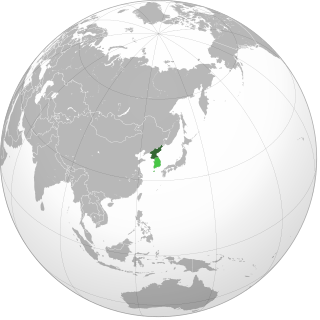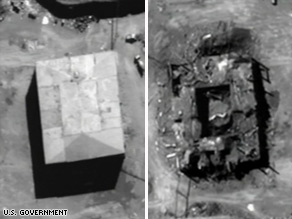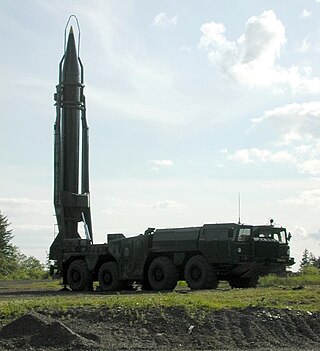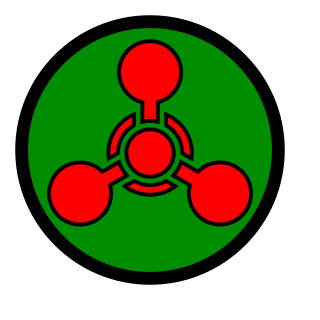Related Research Articles

Mustard gas or sulfur mustard are names commonly used for the organosulfur chemical compound bis(2-chloroethyl) sulfide, which has the chemical structure S(CH2CH2Cl)2, as well as other species. In the wider sense, compounds with the substituents −SCH2CH2X or −N(CH2CH2X)2 are known as sulfur mustards or nitrogen mustards, respectively, where X = Cl or Br. Such compounds are potent alkylating agents, making mustard gas acutely and severely toxic. Mustard gas is a carcinogen. There is no preventative agent against mustard gas, with protection depending entirely on skin and airways protection, and no antidote exists for mustard poisoning.

North Korea has a military nuclear weapons program and, as of 2024, is estimated to have an arsenal of approximately 50 nuclear weapons and sufficient production of fissile material for six to seven nuclear weapons per year. North Korea has also stockpiled a significant quantity of chemical and biological weapons. In 2003, North Korea withdrew from the Treaty on the Non-Proliferation of Nuclear Weapons (NPT). Since 2006, the country has conducted six nuclear tests at increasing levels of expertise, prompting the imposition of sanctions.

The Hwasong-7 is a single-stage, mobile liquid propellant medium-range ballistic missile developed by North Korea. Developed in the mid-1980s, it is a scaled-up adaptation of the Soviet R-17 Elbrus missiles, more commonly known by its NATO reporting name "Scud". The inventory is estimated to be around 200–300 missiles. US Air Force National Air and Space Intelligence Center estimates that as of June 2017 fewer than 100 launchers were operationally deployed.

Many nations continue to research and/or stockpile chemical weapon agents despite numerous efforts to reduce or eliminate them. Most states have joined the Chemical Weapons Convention (CWC), which required the destruction of all chemical weapons by 2012. Twelve nations have declared chemical weapons production facilities and six nations have declared stockpiles of chemical weapons. All of the declared production facilities have been destroyed or converted for civilian use after the treaty went into force.

Beginning in the mid-1930s, Japan conducted numerous attempts to acquire and develop weapons of mass destruction. The 1943 Battle of Changde saw Japanese use of both bioweapons and chemical weapons, and the Japanese conducted a serious, though futile, nuclear weapon program.
During the Iran–Iraq War, both Iran and Iraq received large quantities of weapons.

Libya pursued programs to develop or acquire weapons of mass destruction from when Muammar Gaddafi seized control of Libya in 1969 until he announced on 19 December 2003 that Libya would voluntarily eliminate all materials, equipment and programs that could lead to internationally proscribed weapons. This included weapons of mass destruction and long-range ballistic missiles.

Operation Outside the Box, also known as Operation Orchard, was an Israeli airstrike on a suspected nuclear reactor, referred to as the Al Kibar site, in the Deir ez-Zor region of Syria, which occurred just after midnight on 6 September 2007. The Israeli and U.S. governments did not announce the secret raids for seven months. The White House and Central Intelligence Agency (CIA) subsequently confirmed that American intelligence had also indicated the site was a nuclear facility with a military purpose, though Syria denies this. A 2009 International Atomic Energy Agency (IAEA) investigation reported evidence of uranium and graphite and concluded that the site bore features resembling an undeclared nuclear reactor. IAEA was initially unable to confirm or deny the nature of the site because, according to IAEA, Syria failed to provide necessary cooperation with the IAEA investigation. Syria has disputed these claims. Nearly four years later, in April 2011 during the Syrian Civil War, the IAEA officially confirmed that the site was a nuclear reactor. Israel did not acknowledge the attack until 2018.

Syria and weapons of mass destruction deals with the research, manufacture, stockpiling and alleged use by Syria of weapons of mass destruction, which include chemical and nuclear weapons.

Operation CHASE was a United States Department of Defense program for the disposal of unwanted munitions at sea from May 1964 until the early 1970s. Munitions were loaded onto ships to be scuttled once they were at least 250 miles offshore. While most of the sinkings involved conventional weapons, four of them involved chemical weapons. The disposal site for the chemical weapons was a three-mile (5 km) area of the Atlantic Ocean between the coast of the U.S. state of Florida and the Bahamas. Other weapons were disposed of in various locations in the Atlantic and Pacific oceans. The CHASE program was preceded by the United States Army disposal of 8,000 short tons of mustard and lewisite chemical warfare gas aboard the scuttled SS William C. Ralston in April 1958. These ships were sunk by having Explosive Ordnance Disposal (EOD) teams open seacocks on the ship after they arrived at the disposal site. The typical Liberty ship sank about three hours after the seacocks were opened.

The R-17 Elbrus, GRAU index 9K72 is a tactical ballistic missile, initially developed by the Soviet Union. It is also known by its NATO reporting name SS-1C Scud-B. It is one of several Soviet missiles to carry the reporting name Scud; the most prolifically launched of the series, with a production run estimated at 7,000 (1960–1987). Also designated R-300 during the 1970s, the R-17 was derived from the R-11 Zemlya. It has been operated by 32 countries and manufactured in four countries outside the Soviet Union. It is still in service with some. The North Koreans reverse-engineered it as the Hwasong-5.

A Scud missile is one of a series of tactical ballistic missiles developed by the Soviet Union during the Cold War. It was exported widely to both Second and Third World countries. The term comes from the NATO reporting name attached to the missile by Western intelligence agencies. The Russian names for the missile are the R-11, and the R-17Elbrus. The name Scud has been widely used to refer to these missiles and the wide variety of derivative variants developed in other countries based on the Soviet design.

A chemical weapon (CW) is a specialized munition that uses chemicals formulated to inflict death or harm on humans. According to the Organisation for the Prohibition of Chemical Weapons (OPCW), this can be any chemical compound intended as a weapon "or its precursor that can cause death, injury, temporary incapacitation or sensory irritation through its chemical action. Munitions or other delivery devices designed to deliver chemical weapons, whether filled or unfilled, are also considered weapons themselves."

The January 2013 Rif Dimashq airstrike was an aerial attack in the Rif Dimashq Governorate of Syria, which targeted a convoy alleged to be carrying weapons from Syria to the Lebanese Shi'a militia Hezbollah. The convoy was attacked on 31 January 2013. According to several media sources, Israeli forces allegedly conducted the strike; however, Israel has not officially responded to the allegations.
The Centre d'études et de recherches scientifiques (CERS), is a Syrian government agency that has the goal of advancing and coordinating scientific and military research activities in the country. It works on research and development for the economic and social development of Syria, especially the computerization of government agencies. It is considered to have better technical capacity and equipment than the Syrian universities. Jane's Information Group Intelligence Services and other analysts believe it is responsible for research and development of nuclear, biological, chemical and missile technology and weapons, including ballistic missiles, as well as advanced conventional arms.

Since the 1980s there has been an ongoing proxy conflict between Iran and Israel. Motivated by the periphery doctrine, Imperial Iran and Israel had close relations, seeing Arab powers as a common threat. After the 1979 Islamic revolution, Iran cut off relations, but covert ties continued during the subsequent Iran–Iraq War. Iran trained and armed Hezbollah during Israel's 1982 invasion of Lebanon, and continued to back Shia militias throughout the Israeli occupation of Southern Lebanon. Even before 1979, Iranian Islamists had materially supported the Palestinians; after 1979 Iran attempted relations with the Palestine Liberation Organization, and later with Palestinian Islamic Jihad and Hamas. Israel fought a war with Hezbollah in 2006.
The United States chemical weapons program began in 1917 during World War I with the creation of the U.S. Army's Gas Service Section and ended 73 years later in 1990 with the country's practical adoption of the Chemical Weapons Convention. Destruction of stockpiled chemical weapons began in 1986 and was completed on July 7, 2023. The U.S. Army Medical Research Institute of Chemical Defense (USAMRICD), at Aberdeen Proving Ground, Maryland, continues to operate.
Syria's chemical weapons program began in the 1970s with weapons and training from Egypt and the Soviet Union, with production of chemical weapons in Syria beginning in the mid-1980s. For some time, Syria was believed to have the world's third-largest stockpile of chemical weapons, after the United States and Russia. Prior to September 2013 Syria had not publicly admitted to possessing chemical weapons, although Western intelligence services believed it to hold one of the world's largest stockpiles. In September 2013, French intelligence put the Syrian stockpile at 1,000 tonnes, including Yperite, VX and "several hundred tonnes of sarin". At the time, Syria was one of a handful of states which had not ratified the Chemical Weapons Convention. In September 2013, Syria joined the CWC, and agreed to the destruction of its weapons, to be supervised by the Organisation for the Prohibition of Chemical Weapons (OPCW), as required by the convention. A joint OPCW-United Nations mission was established to oversee the destruction process. Syria joined OPCW after international condemnation of the August 2013 Ghouta chemical attack, for which Western states held the Syrian government responsible and agreed to the prompt destruction of its chemical weapons.

Egypt had a history of weapons of mass destruction and used chemical weapons during the North Yemen Civil War. Although it has signed the Nuclear Non-Proliferation Treaty, it still remains one of only four countries not to ratify the Chemical Weapons Convention and has not ratified the Biological Weapons Convention.

Iraq–North Korea relations are relations between North Korea and Iraq. The two states are part of what is called the "Axis of Evil", countries presented by the George W. Bush administration as wishing to obtain weapons of mass destruction and supporting terrorism, along with Iran. Iraq was removed from the U.S. State Sponsors of Terrorism list in 2004.
References
- ↑ The Spies Inside Damascus Foreign Policy Magazine, BY RONEN BERGMAN, 19 September 2013
- ↑ "Middle East | Deadly blast at Syrian arms depot". BBC News. 26 July 2007. Retrieved 5 September 2013.
- ↑ "Archived copy". Archived from the original on 12 August 2013. Retrieved 27 August 2013.
{{cite web}}: CS1 maint: archived copy as title (link) - ↑ "The Times & the Sunday Times". Archived from the original on 16 November 2007.
- ↑ "North Korea and Syrian chemical and missile programs - North Korea News". NK News - North Korea News. 19 June 2013. Retrieved 27 February 2018.
- ↑ Schwirtz, Michael (18 January 2018). "U.N. Links North Korea to Syria's Chemical Weapon Program". The New York Times. Retrieved 27 February 2018.
- ↑ John Pike. "Chemical Weapons - Syria". Globalsecurity.org. Retrieved 5 September 2013.
- ↑ John Pike. "Missile Programs - Syria". Globalsecurity.org. Retrieved 5 September 2013.